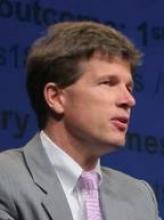ORLANDO – Eliminating drug copayments for patients following a myocardial infarction reduced vascular events without increasing overall costs for insurers in the prospective randomized MI FREEE trial.
Although the Post-Myocardial Infarction Free Rx Event and Economic Evaluation trial had only a "modest" impact on medication adherence and missed its primary end point, the findings were dramatic enough that study sponsor Aetna has announced it will waive copayments for its post-MI patients beginning January 2013, lead author Dr. Niteesh Choudhry said at the annual scientific sessions of the American Heart Association.
"As the very first step in the idea of translation into practice, it’s not a flippant comment to say this could be translated tomorrow," he said. "The mechanisms we used are widely generalizable."
The trial randomly assigned 5,855 post-MI patients covered by Aetna to usual prescription coverage or full coverage so patients faced no copays for all brand and generic statins, beta-blockers, ACE inhibitors, or angiotensin-receptor blockers. Randomization occurred at about 49 days post discharge.
The trial’s primary composite end point of rate of major vascular event or revascularization was similar at 17.6 per 100 person-years for patients in the full coverage group vs. 18.8 per 100 person-years in the usual care group.
When evaluated separately, however, patients given free drugs had a statistically significant 14% decrease in major vascular events, defined as fatal or nonfatal MI, unstable angina, congestive heart failure or stroke, said Dr. Choudhry, an internist and researcher at Harvard Medical School in Boston.
The rate of stroke was also significantly reduced (HR 0.69).
In the full-coverage group, rates of medication adherence, defined as the number of days covered, increased 4.4% for beta-blockers, 6.2% for statins, 5.6% for ACE/ARBs, and by 5.4% to 43.9% for all three classes. Rates for full adherence, defined as the number of patients taking 80% of their medications, increased significantly, by 32%, 37%, 31% and 41%, respectively.
The low baseline adherence and small improvement in adherence in what should have been a highly motivated group of patients after MI was described as perhaps "the most sobering findings" of the trial in an editorial (N. Engl. J. Med. 2011 [doi:10.1056/NEJMe1111558]) that accompanied the simultaneous publication of the study (N. Engl. J. Med. 2011 [doi:10.1056/NEJMsa1107913]).
Invited discussant Dr. Eric Peterson, professor of medicine in cardiology and associate director of the Duke Clinical Research Institute in Durham, N.C., said MI FREEE highlights the huge challenge for post-MI secondary prevention, even when medications are given gratis.
"Adherence rates for any one of these medicines that can alter the course of disease with myocardial infarction was under 50%, and [when] combined, only one in 10 patients consistently took all three of these medicines," he said. "Thus, as Dr. Chaudhry noted, we need to get much better and have novel interventions to improve adherence long term."
Dr. Choudhry said the next step in their research is to provide financial incentives to patients to remain medication adherent.
"There are some concerns about paying patients, but providing positive financial incentives is the next step in the game," he said. "If you call this value-based insurance, we call that VBI 2.0. It’s the next innovation.
"From an economic perspective, you could come up with the amount of money that you’ve saved in copays and instead give that as a positive incentive."
Dr. Mariell Jessup, medical director of the Penn Heart and Vascular Center in Philadelphia, suggested that the trial may have had a better outcome if patients were notified the day they left the hospital that they were getting free drugs.
"I think that resets something," she said in an interview. "People are overwhelmed if they have a whole lot of pills to take and then they go to the drug store for the first time and get the bill, and we lose them."
One of the gaps in the study, however, is the failure to include clopidogrel (Plavix) and atorvastatin (Lipitor) in the equation, Dr. Jessup noted.
During a panel discussion of the study, AHA immediate past president Dr. Clyde Yancy, chief of cardiology at Northwestern University in Chicago, said clinicians and patients don’t always value the same clinical trial end points and that patients would likely view an intervention that is safe, effective, and saves them money as more than just a "modest" improvement.
"There are some concerns about paying patients, but providing positive financial incentives is the next step in the game."
As expected, rates of patient out-of-pocket spending in the full-coverage group dropped by 30% for drugs, but were also significantly cut for medical services by 18% and for total overall spending by 26%. This translated into a savings of $526 per patient over the trial, Dr. Chaudhry said.


